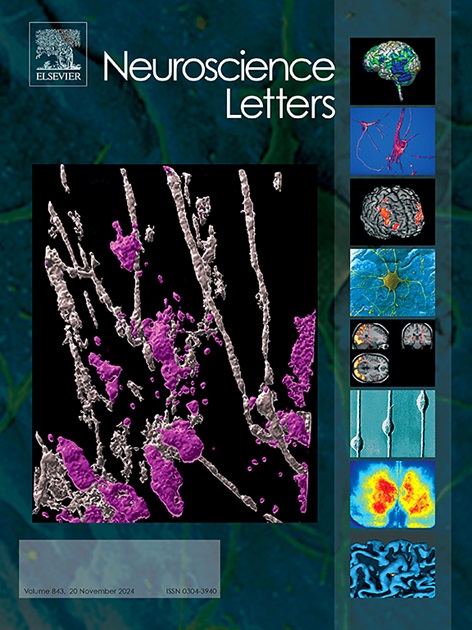脑卒中后可通过调节钙调磷酸酶和心磷脂动态来缓解线粒体功能障碍和衰老。
IF 2
4区 医学
Q3 NEUROSCIENCES
引用次数: 0
摘要
线粒体在缺血性卒中病理生理中的重要影响为治疗策略和临床结果提供了许多尚未探索但有希望的途径。脑卒中后线粒体功能障碍导致钙超载和细胞凋亡水平加重。这种功能障碍表现为线粒体脂质(如心磷脂)的破坏,以及线粒体DNA突变,导致线粒体自噬失衡。据报道,钙超载介导的钙调磷酸酶过表达会加剧线粒体损伤,并进一步导致神经元凋亡。在我们的研究中,我们探讨了脑卒中后钙介导的钙调磷酸酶水平被抑制后线粒体功能的变化。在大脑中动脉闭塞(MCAo)的啮齿动物模型中,我们观察到脑卒中后钙通道的抑制导致抗氧化剂水平上调后神经元组织学和活力的恢复。在线粒体水平上,钙通道抑制可下调脑卒中后钙调磷酸酶的激活,使心磷脂浓度、线粒体膜电位和呼吸控制率正常化。这种抑制也平衡了线粒体动力学蛋白和线粒体自噬对缺血应激后神经元恢复的影响。此外,它还使TERT的表达正常化,TERT是线粒体健康和衰老的关键标志。这些发现强调了钙介导的钙调神经磷酸酶在影响缺血性卒中线粒体功能障碍和衰老中的作用。因此,钙通道抑制提供了一个有希望的治疗策略,通过保持线粒体完整性和促进中风后的神经保护。本文章由计算机程序翻译,如有差异,请以英文原文为准。
Mitochondrial dysfunction and aging can be alleviated by modulating calcineurin and cardiolipin dynamics following stroke
The crucial influence of mitochondria in ischemic stroke pathophysiology presents many unexplored yet promising avenues for therapeutic strategies and clinical outcomes. Post-stroke mitochondrial dysfunction contributes to aggravated levels of calcium overload and apoptosis. This dysfunction is signified by disruption of the mitochondrial lipids such as cardiolipin, along with mitochondrial DNA mutation, leading to an imbalance in mitophagy. Calcium overload-mediated calcineurin overexpression has been reported to exacerbate mitochondrial damage and further contribute to neuronal apoptosis. In our study, we explored the alterations in the mitochondrial function following inhibition of the calcium-mediated calcineurin levels in post-stroke condition. In a rodent model of middle cerebral artery occlusion (MCAo), we observed that the inhibition of the calcium channels in post-stroke condition led to restored neuronal histology and viability following upregulation of the antioxidant levels. At the mitochondrial level, calcium channel inhibition downregulated calcineurin activation and normalized cardiolipin concentration, mitochondrial membrane potential, and respiratory control ratio in post-stroke condition. This inhibition also balanced the mitochondrial dynamics proteins and mitophagy towards neuronal recovery following ischemic stress. Moreover, it also normalized the expression of TERT, a key marker of mitochondrial health and aging. These findings highlight the role of calcium-mediated calcineurin in influencing mitochondrial dysfunction and aging in ischemic stroke. Thus, calcium channel inhibition offers a promising therapeutic strategy by preserving mitochondrial integrity and promoting neuroprotection following stroke.
求助全文
通过发布文献求助,成功后即可免费获取论文全文。
去求助
来源期刊

Neuroscience Letters
医学-神经科学
CiteScore
5.20
自引率
0.00%
发文量
408
审稿时长
50 days
期刊介绍:
Neuroscience Letters is devoted to the rapid publication of short, high-quality papers of interest to the broad community of neuroscientists. Only papers which will make a significant addition to the literature in the field will be published. Papers in all areas of neuroscience - molecular, cellular, developmental, systems, behavioral and cognitive, as well as computational - will be considered for publication. Submission of laboratory investigations that shed light on disease mechanisms is encouraged. Special Issues, edited by Guest Editors to cover new and rapidly-moving areas, will include invited mini-reviews. Occasional mini-reviews in especially timely areas will be considered for publication, without invitation, outside of Special Issues; these un-solicited mini-reviews can be submitted without invitation but must be of very high quality. Clinical studies will also be published if they provide new information about organization or actions of the nervous system, or provide new insights into the neurobiology of disease. NSL does not publish case reports.
 求助内容:
求助内容: 应助结果提醒方式:
应助结果提醒方式:


